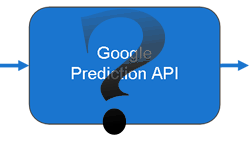:Multi-category prediction: Imagine you’re writing a news aggregator that suggests articles based on the kinds of stories the user has read before. Previously, using the Prediction API, each article could only be tagged with one label - the most pertinent one. For example, an article about a new truck might be labeled as “truck,” but not “roomy” or “quiet.” Now articles can be tagged with all of those labels, with the labels ranked by pertinence, enabling your app to make better recommendations.
Continuous Output: You’d like to create a wine recommendation app. Matching a wine to personal preferences is a tricky task, dependent on many factors, including origin, grape, age, growing environment, and flavor presence. Previously, your app could only label wine as “good,” “decent,” “bad,” or some other set of pre-defined values. Using the new continuous output option, your app can provide a fine-grained ranking of wines based on how well they fit the user’s preferences.
Mixed Inputs: You’re creating an automatic moderator for your blog. You could already classify incoming posts automatically based on comment text and the username of the poster (text inputs), but not the number of times they’ve posted before or the number of users that have liked their posts (numeric inputs). We’ve now added support for mixed inputs, so both numeric and text data can be incorporated in your moderation helper, greatly improving accuracy and letting you get back to making content rather than managing it.
Combining Continuous Output with Mixed Inputs: To further enhance your automatic moderator, you can use continuous output to set thresholds for automatic posting, automatic rejection and manual moderation, further reducing your workload.
You can get all the details about these and other new features on the Prediction API website.
The only other bad news is that this is a closed trial. The Prediction API is being offered as a preview to a limited number of developers. There is no charge for using the service during the preview but it is difficult to see why Google would provide such a service in the future for free. A more worrying point is that as the details of the model are never released to the end user Google, in principle, has more access to your results than you do. Without detailed metrics on performance and graphics showing how the algorithm is working it can be difficult to know why a classification isn't working well. Often a small tweak, like a transform on an input variable, can turn a poor model into a good one. The black box approach may simplify things but it also means you have to put your trust in Google.

Perhaps this is the future of commercial AI - black box services provided by big companies.
To learn more and sign up for an invitation, please join the waitlist.
Google Announces Application Design Center 10/04/2025 Google has announced the public preview of Application Design Center, a service that combines combines Gemini Cloud Assist chat with a visual, canvas-style interface for app development. |
ASP.NET Core 10 Preview Released 31/03/2025 Microsoft has announced the second preview release of .NET 10 with enhancements across the .NET Runtime, SDK, libraries, C#, ASP.NET Core, Blazor, and .NET MAUI. |
More News
|
<ASIN:059652272X>
<ASIN:1934356565>
<ASIN:059680069X>
<ASIN:143022665X>
<ASIN:0470464933>
<ASIN:1430229829>

